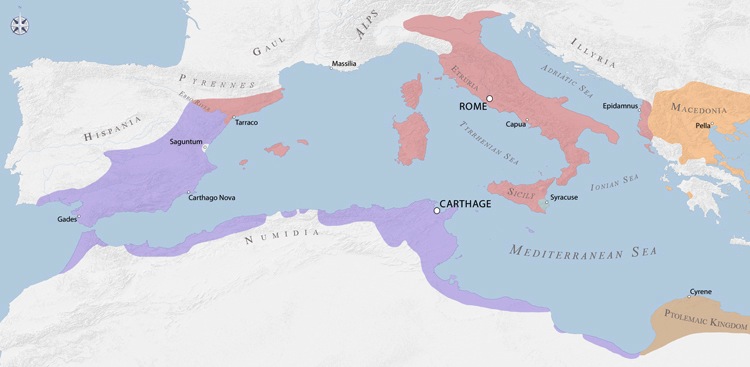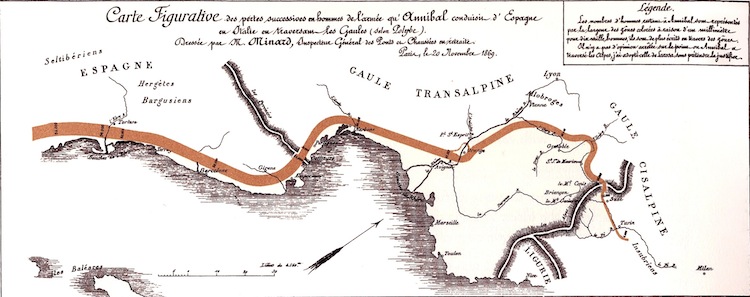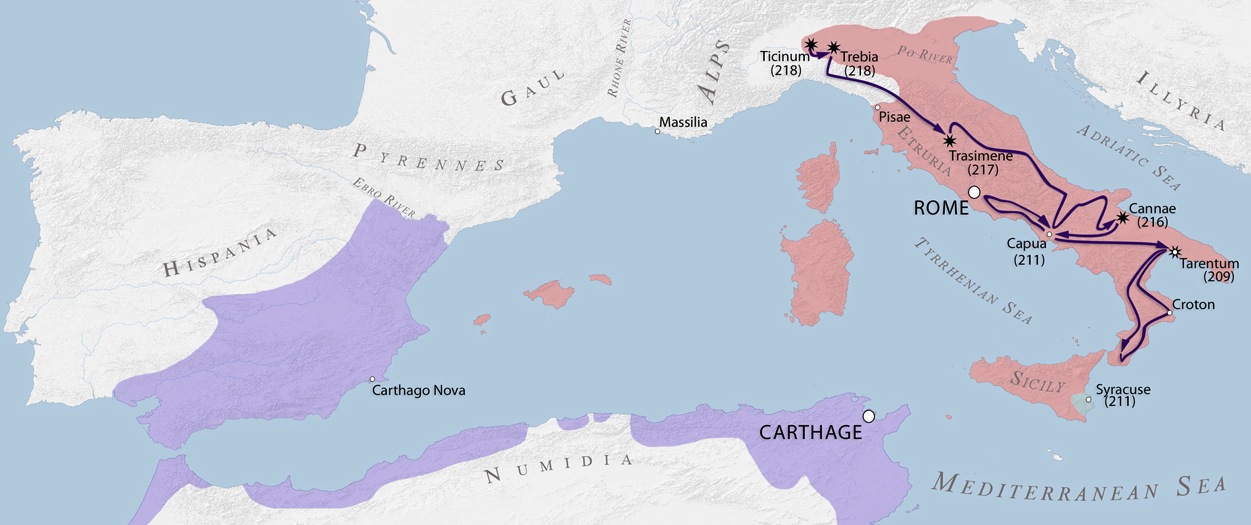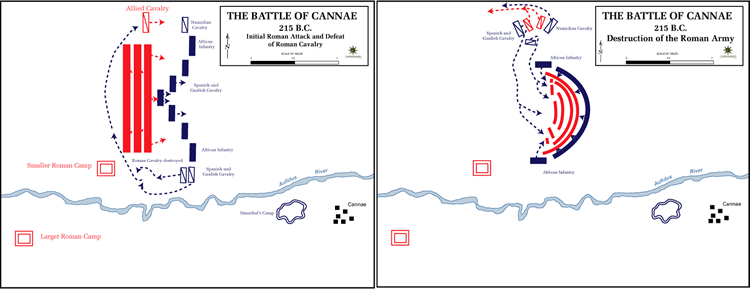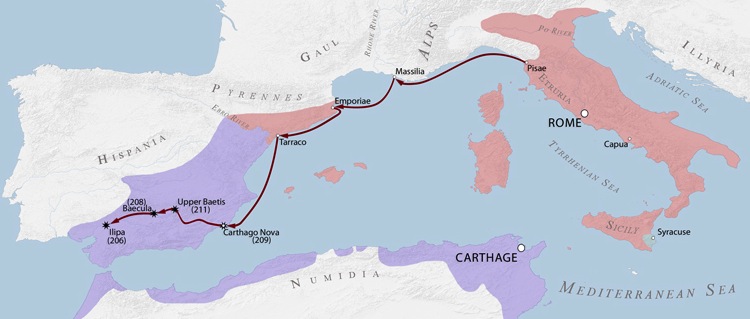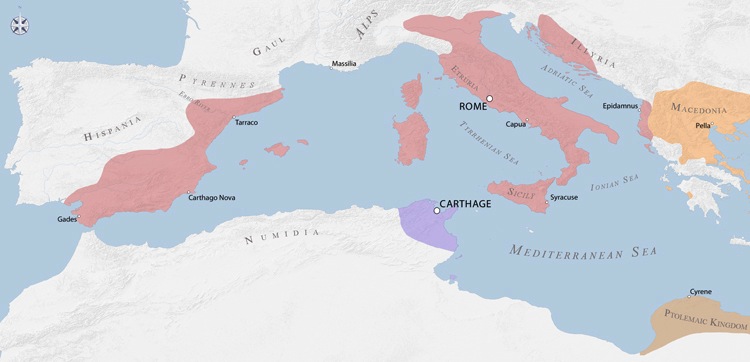Second Punic War (218-201 BC)
In 219 BC, Hannibal laid siege to Saguntum, a coastal city in northeast Hispania that enjoyed a long-standing treaty of friendship with Rome. In 226 BC, however, Hasdrubal the Fair signed a treaty with Rome that acknowledged Carthage's control of Hispania south of the Ebro River. Saguntum's status, therefore, was ambiguous: was it an ally of Rome or a ward of Carthage? When the besieged Saguntines appealed to Rome, Rome pressured the Carthaginians to recognize their alliance with Saguntum. Even as the Romans attempted to negotiate a settlement to the crisis, Hannibal captured the city after an eight-month siege. When Carthage refused Roman demands for Hannibal's extradition, both sides prepared for war.
Rome and Carthage enjoyed different military advantages than they had during the last war. Hannibal now fielded the best-trained and equipped army in the ancient world; the Romans enjoyed complete naval superiority, which they could use to invade Carthaginian territory at will. Rome expected to exploit this advantage to wage a quick, offensive war that would compel Carthage to sue for peace on Rome's terms. Hannibal, however, had a plan to restore Carthage's supremacy in the western Mediterranean. First, he would neutralize Rome's advantage at sea through a daring invasion of Italy across the Alps. Hannibal correctly saw that the presence of a foreign army in Italy would compel the Romans to abandon their planned assault on Carthage. Once across the Alps, Hannibal planned to recruit soldiers from the recently conquered regions of northern and southern Italy and convince other kingdoms in the East to join forces against Rome. At the head of this combined force, Hannibal would cut at the roots of Roman military power by disrupting the intricate web of alliances that bound the cities and peoples of Italy to Rome. It is important to note that Hannibal's goal at the start of the war was not to destroy the city or exterminate the Romans, despite the claims made by later Roman authors. Hannibal assumed that a few decisive victories in Italy would compel Rome to negotiate a new peace treaty on terms favorable to Carthage. At the least, he thought he could win a restoration of Carthaginian holdings in Sicily and Sardinia and a recognition of their empire in Hispania. Roman resolve, however, would again surprise the Carthaginians.
At the start of the war, the Romans assumed that Hannibal, whose army was in constant danger of being outflanked by sea, would seek to protect Carthage's hard-won territory in northern Hispania. The Roman strategy assumed that one army would pin Hannibal down in Hispania, freeing another to invade the Carthaginian homeland in Africa. But Hannibal, ever bold, seized the initiative and marched towards Italy with a large army. He evaded the first Roman army sent against him and arrived at the Alps in late 218 BC with 38,000 infantry troops, 8,000 cavalrymen, and 37 war elephants. The brutal march over the mountains in the early winter cost Hannibal nearly a third of his army and most of his irreplaceable elephants. But his gamble worked. He was able to lead an intact army into Italy. Hannibal then won a cavalry engagement at Ticinus and forced the Romans to withdraw south of the Padus River. Facing an enemy army in Italy, the Romans recalled the forces that were being marshaled for the planned invasion of Africa. Hannibal had succeeded in forestalling the invasion of Carthage. His audacity had gained him the chance to win the war in Italy.
In quick succession, Hannibal inflicted two crushing defeats on a stunned and unprepared Rome. At Trebia, 30,000 freezing Roman soldiers were lured into an ambush and killed [Trebia Battle Schematic]. Hannibal then crossed the Padus River into central Italy. Despite the shocking defeat, Rome refused to negotiate terms with the invader. In 217, the two consuls raised a new army and led it against Hannibal. At Lake Trasimene, Hannibal again demonstrated his mastery of battlefield tactics when the consul Gaius Flaminius Nepos and more than 40,000 soldiers were ambushed on the narrow path along the shore of the lake. Nearly all of the Roman soldiers in Flaminius' army were either killed or captured [Trasimene Battle Schematic]. After this second disaster, Rome was seized by panic and memories of the Gallic Sack of 390 BC. But still the Romans refused to surrender or even negotiate an exchange of prisoners. Instead, Fabius Maximus was elected dictator and invested with unlimited power to confront the threat to Rome.
Unlike his impetuous colleagues, Fabius accurately assessed the tactical and strategic situation facing Rome. Fabius realized that Hannibal's decisive advantage in cavalry forces made it too risky to engage him in a large-scale battle on level ground. He also recognized that Rome's superior manpower would eventually yield victory, provided that he could thwart Hannibal's strategic goal of separating Rome from her Italian allies. Fabius therefore avoided a direct confrontation with Hannibal's forces. He focused instead on protecting Rome's allies and wearing down Hannibal's army through small raids. This "Fabian" tactic of avoiding decisive battle spared Rome's soldiers and preserved Rome's alliances, but his caution lost him favor among the more aggressive-minded Roman senators who were eager to confront Hannibal, as well as many other Roman citizens whose property was being destroyed by Hannibal's army.
Unchecked, Hannibal ranged throughout Italy, eventually destroying 400 towns and capturing several large cities. In the face of such devastation, two new consuls were elected on the promise to make short work of Hannibal. Under the burning summer sky, the largest army that Rome would ever field within Italy marched to crush what they saw as Hannibal's gaggle of barbarians. Outside of the strategic town of Cannae, however, Hannibal annihilated both consular armies: as many as 70,000 Romans and allies were butchered in a single afternoon—among the worst defeats ever suffered by Rome, or indeed by any army.
Rome's allies began to waver as Hannibal's successes mounted. Several major cities revolted, as did large swaths of southern Italy. Soon after Cannae, another army was destroyed while attempting to pacify a Gallic tribe that had defected to Hannibal. Hannibal's army and his allies had killed upwards of 175,000 Roman and Italian soldiers in just over 20 months. At this moment, Philip of Macedon agreed to open a second front against Roman interests in Illyria. By almost any reckoning, Hannibal had won the war. Rome's power base had been reduced to central Italy and Sicily. It had lost the core of its army and a large portion of its military and political aristocracy, its allies were abandoning it, and rival powers were beginning to line up behind Hannibal, who must have thought he was on the verge of victory. Yet even in the face of these manifold disasters, Rome rejected even the thought of peace on Hannibal's terms. It banned public displays of mourning, refused to negotiate, and began recruiting new armies. Improbably, the war had only just begun.
In this moment of crisis, Rome resumed the Fabian strategy. Decisive battles were avoided whenever possible, allies were protected, disloyal or captured cities were slowly re-conquered. The Romans deployed their fleet to limit reinforcements from Philip of Macedon or Carthage. They used clever diplomacy to enmesh Philip in a costly and distracting war in Greece. With the immediate crisis averted, Rome's superiority in manpower and organization eventually began to turn the tide. During the decade from 215 to 205 BC Rome fielded as many as seven and never fewer than four two-legion armies every year in Italy. At its peak mobilization in 212 BC, Rome fielded 25 legions and a massive fleet with over 200,000 men, which it used to conduct simultaneous operations from Hispania to Africa to the Aegean. Hannibal, who was never able to field more than three large armies at a time, was thus constantly made to react to Roman operations against his new Italian allies.
In 211, Hannibal at last marched against Rome. It would be more than 600 years before a foreign army would again marshal outside of Rome's gates. Even so, Hannibal was incapable of sustaining a prolonged siege against the well-defended city. This move was only a diversionary tactic to forestall a Roman expedition to Africa. By 209, Rome had retaken most of the cities in Italy and begun to make inroads against Carthaginian territory in Hispania. Hannibal, however, still hoped to win the war. A decade of continual war had wrecked the Italian economy. Rome's allies were exhausted and eager for peace. Even the Latin cities, Rome's staunchest allies, refused new levies, claiming that no men remained in their towns.
At this crucial juncture Hannibal suffered three disastrous setbacks. First his brother Hasdrubal, who was attempting to reinforce Hannibal by land, was killed and his army destroyed at Metaurus in 207. Then Scipio Africanus completed the conquest of Hispania in 206. Finally, a large resupply fleet from Carthage was destroyed in 205. Hannibal's daring gambit—his attempt to destroy Rome's alliances before its superior resources and population could provide it with a decisive advantage—had failed. When Roman forces began operating in North Africa, Hannibal was recalled to defend the Carthaginian homeland.
In 204, Scipio Africanus invaded North Africa and promptly annihilated a large army of Carthaginians and Numidians in a daring nighttime assault. The stage was set for a climactic showdown between Hannibal and Scipio Africanus. In 202 at the Battle of Zama, Hannibal was at last able to deploy war elephants against the Romans. But Scipio had developed tactics to minimize their effectiveness and Hannibal's young, untrained elephants did more damage to the Carthaginians than the Romans. The battle was won when Scipio’s superior Numidian cavalry routed its Carthaginian counterpart and attacked the Carthaginian rear lines. While Roman losses in the battle numbered under 2,000; nearly ten times as many Carthaginians died. [Zama Battle Schematic: Animated].
Even as Hannibal attempted to regroup, Carthage sued for peace. The terms were onerous: Carthage agreed to surrender all territory outside Africa, to wage war only with Roman permission, and to pay a massive indemnity of 5,000 talents (later raised to 10,000) over fifty years. Carthage's empire and its military power were broken. Rome stood unchallenged as the most powerful state in the western Mediterranean.

